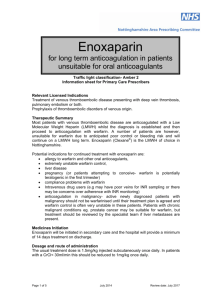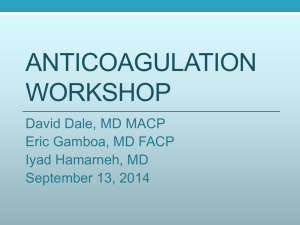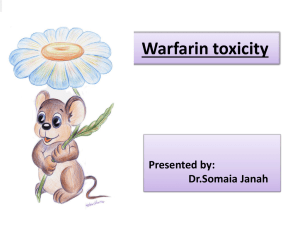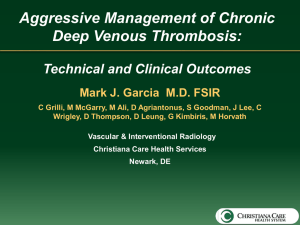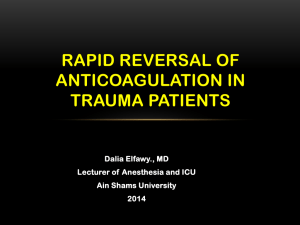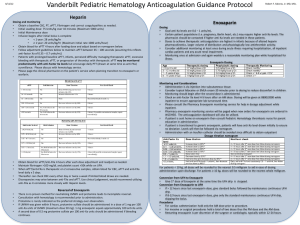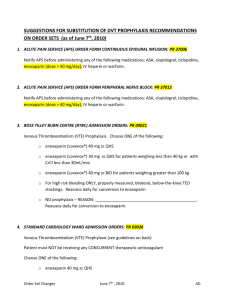Care Pathway Assessment for Adult Patients with Suspected DVT
advertisement
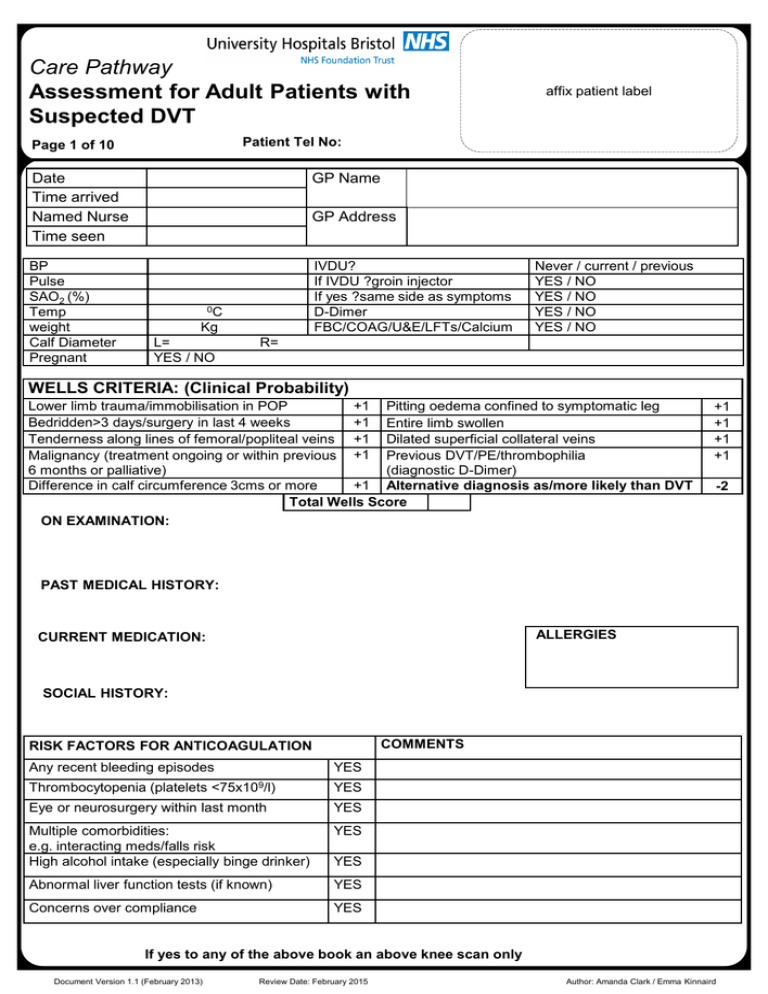
Care Pathway Assessment for Adult Patients with Suspected DVT affix patient label Patient Tel No: Page 1 of 10 Date Time arrived Named Nurse Time seen GP Name BP Pulse SAO2 (%) Temp weight Calf Diameter Pregnant IVDU? If IVDU ?groin injector If yes ?same side as symptoms D-Dimer FBC/COAG/U&E/LFTs/Calcium GP Address 0C Kg L= YES / NO Never / current / previous YES / NO YES / NO YES / NO YES / NO R= WELLS CRITERIA: (Clinical Probability) Lower limb trauma/immobilisation in POP +1 Pitting oedema confined to symptomatic leg Bedridden>3 days/surgery in last 4 weeks +1 Entire limb swollen Tenderness along lines of femoral/popliteal veins +1 Dilated superficial collateral veins Malignancy (treatment ongoing or within previous +1 Previous DVT/PE/thrombophilia 6 months or palliative) (diagnostic D-Dimer) Difference in calf circumference 3cms or more +1 Alternative diagnosis as/more likely than DVT Total Wells Score +1 +1 +1 +1 -2 ON EXAMINATION: PAST MEDICAL HISTORY: ALLERGIES CURRENT MEDICATION: SOCIAL HISTORY: COMMENTS RISK FACTORS FOR ANTICOAGULATION Any recent bleeding episodes Thrombocytopenia (platelets YES <75x109/l) YES Eye or neurosurgery within last month YES Multiple comorbidities: e.g. interacting meds/falls risk High alcohol intake (especially binge drinker) YES Abnormal liver function tests (if known) YES Concerns over compliance YES YES If yes to any of the above book an above knee scan only Document Version 1.1 (February 2013) Review Date: February 2015 Author: Amanda Clark / Emma Kinnaird Care Pathway Assessment for Adult Patients with Suspected DVT affix patient label Page 2 of 10 Score <1 LOW RISK D dimer indicated Result = IVDU D dimer not indicated – direct to imaging. Send bloods to pathology Refer patient for DUPLEX SCAN NB if risk factors for bleeding above knee only scan D dimer raised Send bloods to pathology D dimer not raised PREGNANT⃰ Score >2 HIGH RISK Score 1-2 MODERATE RISK If the scan cannot be performed on the same day consider treatment dose Enoxaparin in the interim (especially in pregnant women) Full leg scan No DVT No Above Knee DVT Calf not scanned No DVT Discharge with advise to see GP if symptoms persist: Date / Time: Isolated Superficial Thrombophlebitis DVT confirmed Explain result to patient send and fax Take blood for D dimer (if not done) Explain results to patient Refer back to GP send and fax ‘No evidence of DVT’ letter Inconclusive ‘inconclusive scan’ letter OR ‘No above knee DVT’ letter Rebook above knee scan in 1 week Date: Time: Advise to return sooner if symptoms worsen No DVT INVESTIGATIONS FBC U/E LFT Date Repeat scan CONTINUE ON PATHWAY DVT confirmed Urinalysis Results Hb MCV Platelets Creat. Urea Na K Bilirubin ALP Protein Albumin PT secs INR APTT secs APTTR Inform GP if urinalysis positive Pregnancy test Recommended in all women of childbearing potential if not known to be pregnant. Clotting Screen WBC Calcium eGFR ALT Globulin D-dimer Pregnant women: discuss all women with positive scans in with the on call obstetric and gynae registrar bleep 2922. If no DVT inform referring Dr SIGNATURE Document Version 1.1 (February 2013) PRINT Review Date: February 2015 Author: Amanda Clark / Emma Kinnaird Care Pathway Assessment for Adult Patients with Suspected DVT affix patient label Page 3 of 10 MANAGEMENT OF PATIENTS WITH A CONFIRMED DEEP VEIN THROMBOSIS 1. Does the patient have risk factors for bleeding? Discuss with Haematology: (registrar bleep 2677) Outcome of the discussion: 2. Can the patient be managed as an out-patient? If YES to any of the following questions discuss with GPSU medical staff to agree a management plan aiming to manage in the community if possible. * circle those that apply Symptoms suggestive of pulmonary embolism: New shortness of breath; New cough; New chest pain; New haemoptysis* YES / NO Active or recent bleeding: (within last 4 weeks) Haemoptysis; Melaena; Haematemesis; Frank Haematuria; intra-cranial bleeding* YES / NO Bleeding risk e.g. liver disease, active peptic ulcer YES / NO Concurrent medical problem requiring admission YES / NO Severe hepatic/renal impairment YES / NO Patient frail/unsteady/unable to mobilise/in severe pain YES / NO Unable to comply with return or follow-up YES / NO 3. Symptoms requiring further investigation: If YES to any of the following questions: discuss with GPSU to organise urgent onward investigations (in most cases these will be done as an outpatient) Unintentional weight loss >7lbs 3Kg in last 6 months YES / NO Bilateral DVT YES / NO Persistent cough YES / NO Recent unexplained abdominal pain YES / NO Abdominal distension YES / NO Haematuria – if current refer directly to urology to consider admission YES / NO New prostatic symptoms – nocturia, increased urinary symptoms, poor stream If yes or ALL men over 60yrs check PSA YES / NO N/A Unexplained pv bleeding - refer directly to gynaecology YES / NO / N/A Breast lumps/ Breast changes noticed (If they do not perform regular self examination or are uncertain consider GP referral to exclude pathology) Document Version 1.1 (February 2013) Review Date: February 2015 YES / NO Author: Amanda Clark / Emma Kinnaird Care Pathway Assessment for Adult Patients with Suspected DVT affix patient label Page 4 of 10 4. Was there a clear provoking factor? If No to all of the following questions request a Chest X-ray and add name to GPSU weekly X-ray review list. Tick here if CXR requested reviewed by GPSU reported by radiology RISK FACTOR ACTION Surgery within last 90 days YES / NO Hospital admission in last 90 days YES / NO Immobility following lower limb fracture (including POP) YES / NO if yes please specify if yes please specify Pregnancy YES / NO Combined oral contraceptive pill/ Hormone replacement YES / NO Known underlying malignancy YES / NO Known IVDU YES / NO Report as a clinical incident and inform the consultant responsible for the initial episode of care Report as a clinical incident Discuss with on call obstetric registrar bleep 2922 Enoxaparin 1mg/Kg twice daily Advise patient to discuss alternative contraception/symptom control with their GP Refer back to oncologist Enoxaparin 1.5mg/Kg once a day Rivaroxaban OR Enoxaparin 1.5mg/Kg once a day 5. Does the patient need Referral to Haematology clinic?: (Tick which apply) Unprovoked thrombosis (including patients with weak risk factors e.g. travel, minor injuries Recurrent VTE (if <50; all events provoked; or concerns regarding long term anticoagulation) Women of childbearing potential Strong Family history of VTE or thrombophilia Treatment choice after discussion with the patient: Rivaroxaban Enoxaparin then warfarin Enoxaparin only SIGNATURE Document Version 1.1 (February 2013) PRINT Review Date: February 2015 Author: Amanda Clark / Emma Kinnaird Care Pathway Assessment for Adult Patients with Suspected DVT affix patient label Page 5 of 10 CARE PLAN FOR PATIENTS WITH CONFIRMED DVT REQUIRING RIVAROXABAN Explain result of scan and plan of treatment Explain anticoagulant treatment and drug interaction, safety and side effects. Give rivaroxaban patient information leaflet Give UHB DVT leaflet Send and fax “confirmed DVT requiring rivaroxaban” letter to GP Give a three week supply of rivaroxaban 15mg twice daily NB if Creatine Clearance <15ml/min DO NOT give rivaroxaban – discuss with MAU team, However do not delay giving first dose if renal function not available DURATION OF TREATMENT: AS PER WARFARIN AND ENOXAPARIN Follow up Appointment in 5-10 days to assess and if appropriate fit compression hosiery Appointment date………………time……………….location……………………. Appointment for review in 3 weeks to switch to once daily treatment 20mg once daily rivaroxaban Appointment date………………time……………….location……………………. Record all visits below. It is important to record all adverse events and discuss with GP/Haematology Date/time Comments Document Version 1.1 (February 2013) Review Date: February 2015 Signature Author: Amanda Clark / Emma Kinnaird Care Pathway Assessment for Adult Patients with Suspected DVT affix patient label Page 6 of 10 Date/time Comments Document Version 1.1 (February 2013) Signature Review Date: February 2015 Author: Amanda Clark / Emma Kinnaird Care Pathway Assessment for Adult Patients with Suspected DVT affix patient label Page 7 of 10 CARE PLAN FOR PATIENTS WITH CONFIRMED DVT REQUIRING WARFARIN THERAPY Target INR: Duration of treatment: Explain results of scan and plan of treatment. Explain anticoagulant therapy, drug interactions, safety and side effects UHB “Deep vein Thrombosis” leaflet Give NPSA oral anticoagulation pack Send and fax “Confirmed DVT requiring Warfarin therapy” letter to GP If baseline INR>1.3 repeat and discuss with Haematology Administer Clexane as per PGD, to continue until INR is >2.0 for two consecutive days or for five …days minimum. Check INR daily: If INR >5 Cross check Coagucheck machine on a venous sample If INR > 6 discuss with Haematologist Dose adjust warfarin on INR according to PGD and write NPSA anticoagulation record Ensure adequate level of analgesia and observe for any signs of cellulitis. On day 5, assess and if appropriate fit for compression hosiery. When INR has been stable and therapeutic for 2 days: Discharge to Anticoagulation pharmacist or …GP Time/Date Comments Signature INR Enoxaparin Warfarin INR Enoxaparin Warfarin INR Enoxaparin Warfarin INR Enoxaparin Warfarin INR Enoxaparin Warfarin Document Version 1.1 (February 2013) Review Date: February 2015 Author: Amanda Clark / Emma Kinnaird Care Pathway Assessment for Adult Patients with Suspected DVT affix patient label Page 8 of 10 Time/Date Comments Signature INR Enoxaparin Warfarin INR Enoxaparin Warfarin INR Enoxaparin Warfarin INR Enoxaparin Warfarin INR Enoxaparin Warfarin INR Enoxaparin Warfarin INR Enoxaparin Warfarin INR Enoxaparin Warfarin INR Enoxaparin Warfarin INR Enoxaparin Warfarin INR Enoxaparin Warfarin INR Enoxaparin Warfarin Document Version 1.1 (February 2013) Review Date: February 2015 Author: Amanda Clark / Emma Kinnaird Care Pathway Assessment for Adult Patients with Suspected DVT affix patient label Page 9 of 10 CARE PLAN FOR PATIENTS WITH CONFIRMED DVT REQUIRING ENOXAPARIN ONLY TREATMENT This care plan is for use in: Pregnant women Patients with known malignancy Intravenous drug users (consider rivaroxaban 1st) Other indications require discussion with Haematology Duration of treatment: Explain results of scan and plan of treatment: If pregnant discuss result with on call Obstetric Registrar. If scan negative or equivocal they may wish to assess or reassess and proceed with treatment if there is a high index of clinical suspicion Teach patient and/or relative to self-inject Give Clexane pack and sharps bin Send and fax “Confirmed DVT requiring Warfarin / Enoxaparin therapy” letter to GP Ensure adequate level of analgesia and observe for any signs of Cellulitis Dose: Standard patients Enoxaparin 1.5mg/kg daily Pregnant Patients Enoxaparin 1mg/kg twice daily Follow up: Between days 5 and 10 - Assess and if appropriate fit for compression hosiery. Check FBC. Arranged. Date: …………………………………………………….. Thereafter: Pregnant women: Ensure Obstetric Team book into first available antenatal clinic Patients with underlying malignancy: refer back to Oncologist Intravenous drug users: refer back to GP SIGNATURE Document Version 1.1 (February 2013) PRINT Review Date: February 2015 Author: Amanda Clark / Emma Kinnaird Care Pathway Assessment for Adult Patients with Suspected DVT affix patient label Page 10 of 10 CARE PLAN FOR PATIENTS WITH SUPERFICIAL THROMBOPHLEBITIS Scan confirms Superficial Thrombophlebitis only Clot extends to within 3cm of sapheno-femoral junction? YES: Therapeutic anticoagulation should be considered for 6 weeks If risk factors present: (PH VTE, active malignancy, anticipated prolonged immobility) Anticoagulate with warfarin (or therapeutic low molecular weight heparin if active malignancy) for 6 weeks No risk factors present: Prophylactic low molecular weight heparin Rescan at 1 week change to therapeutic anticoagulation if no change in scan or progression Scan Rebooked Date: Time: No: NSAIDS have been tried with no improvement? NSAIDS are contraindicated † >5cm area affected Risk factors present YES/NO YES/NO YES/NO YES/NO (PH VTE, active malignancy, anticipated prolonged immobility) † Known allergy to NSAIDS Known asthma Renal Impairment Previous GI bleed / known peptic ulcer disease Discuss with GPSU YES to any Risk assess for Clexane Advise Clexane at prophylactic dose* FBC at 1 week Review at 2 weeks or if symptoms progress and consider therapeutic Enoxaparin. Recommend trial of NSAID Review if deterioration or no resolution at 1 week * Standard prophylactic dose Enoxaparin 40mg once daily. •Weight <50kg 20 mg Enoxaparin b.d •Weight >100kg 40 mg Enoxaparin b.d •Renal failure GFR<30mls/min max enoxaparin 20mg od – discuss risk / benefit with haematology. Send and fax “Superficial Thrombophlebitis ” letter to GP SIGNATURE Document Version 1.1 (February 2013) PRINT Review Date: February 2015 Author: Amanda Clark / Emma Kinnaird
